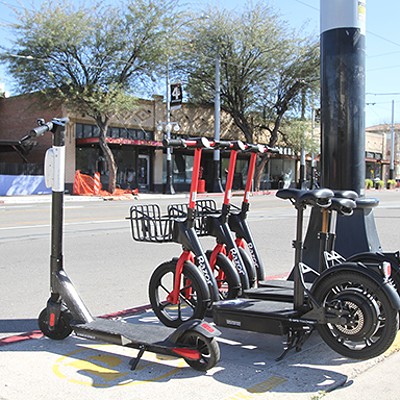"The city is far more reactive than we'd like to be" when it comes to roadway maintenance, says Jim Glock, deputy director of the department. "Of our 1,300 miles of residential streets, we would like to maintain 200 each year. But we actually only do 60."
A lack of sufficient funding for street maintenance is a problem that local transportation officials have been pointing at for years. And it isn't only roadways they are responsible for keeping in shape. These agencies must also maintain washes, street lights, traffic signs and signals, landscaping and alleyways. Pima County even has to plow snow on Mt. Lemmon.
Tucson uses almost $21 million of its state gas tax-generated Highway User Revenue Funds (HURF) for annual maintenance operations, a source that Glock says hasn't kept pace with inflation. The city also spends millions of federal dollars on keeping major streets in driveable condition.
But those amounts aren't nearly enough, in Glock's opinion. His agency recently informed the Citizen Advisory Committee for Tucson's Transportation Future that it would need a total of $150 million to adequately improve just the existing major streets and intersections in town.
The department also earlier estimated it needed $213 million for residential roadway repair and the total reconstruction of almost 550 miles of local streets. These roads, many of which were poorly constructed in the 1950s, are now literally falling apart and need to be rebuilt.
According to Glock, these numbers shocked the citizen committee, which is reviewing the possibility of a May sales tax election for transportation. What the group will recommend to the City Council, however, remains to be seen.
Several years ago the city adopted a plan to maintain all residential streets with either a chip, slurry or fog seal once every seven years. But it has never been able to even come close to that goal. Instead, it does what it can with the funds available. As Glock points out, "We're seeing overall street pavement deterioration and we're just trying to keep things in the condition they are today."
A similar inability to maintain its streets properly was a major problem until recently in the small municipality of South Tucson. Richard Salaz, planning director for that community, says that many of its 26 miles of roadways were dilapidated and probably hadn't had major work done on them in 25 years.
But the 1997 Pima County road bond package helped fix that. It supplied $5 million to rebuild and overlay all the residential streets in South Tucson. Now the town is using its annual maintenance budget of $434,000 to chip seal those streets on a once-every-four-years cycle.
That 25 percent system is far above what officials in Pima County can ever hope to achieve on the almost 2,000 miles of roadways they are responsible for maintaining. Even though his budget has grown rapidly in the last few years, Dave Cummings, division manager of maintenance operations for Pima County, says, "The ideal maintenance program, which probably no one in the county is able to achieve, would be to do 20 percent of the roads every year. Last year Pima County did 4 percent and this year we hope to do 7 and a half percent. Our roads are growing older faster than we can take care of them."
A common problem, as Cummings describes it, is how major streets were often developed in Pima County. "Some roads started out as jeep trails, and over the years when the area developed they became roughed-out dirt roads. Later the county may have added drainage improvements, like culverts, and then paved the road with a double-chip seal. But the roadway wasn't engineered and had no sub-base."
Thus, many roads were built cheaply and haphazardly, and not to last. Their eventual deterioration was a given. "This is a widespread issue," according to Cummings, "and some of these roads are now collectors and arterial streets."
Pima County is also working to rebuild 14 structurally deficient bridges. David Zaleski, structural engineering manager for the county's Department of Transportation, says most of these bridges are in outlying areas and need to be replaced due to age or because their carrying capacity is too low for current needs.
Zaleski expects one-half of the bridges to be rebuilt within six or seven years and hopes all of them can be redone within a decade. One of them, the Palo Verde overpass, is scheduled to be replaced starting in 2004 at an estimated cost of $17 million.
The City of Tucson and Pima County aren't the only agencies short of cash for maintenance. "We're having a hard problem [because of funding]" says Frank Smith, local maintenance superintendent for the Arizona Department of Transportation. "We have a lot of new landscaping but haven't gotten any money to maintain it."
In the Tucson area, ADOT annually spends $940,500 on landscape maintenance and another $3.8 million on maintaining guardrails, shoulders and minor pavement fixes along 691 miles of roadway. It isn't responsible, however, for major roadway repair work. That is supervised by the main office in Phoenix, which spends $100 million a year on maintaining Arizona's highways, but can't break out financial figures exclusively for Pima County.
Like other governmental agencies, ADOT uses a "Pavement Management System" to tell it when to apply the proper maintenance treatments to get the best bang for the buck. Serious lack of funding, however, diminishes the impact of those systems for most jurisdictions, meaning they fill potholes and patch other roadway problems instead of permanently fixing them.
But Tucson's Jim Glock remains optimistic and still has hopes of catching up with all the city's maintenance deficiencies. "Once you've caught up," he says, "it's easier to keep up."











